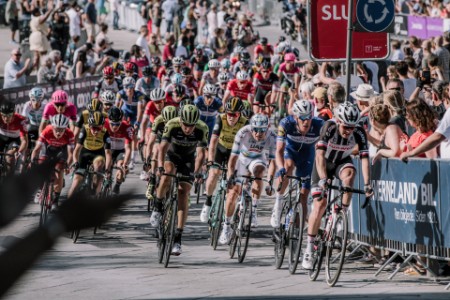
The better the question
How can you turn spectators into fans?
Cycling has a money problem; but with a huge fanbase to draw from, can the sport create a platform that can effectively engage and monetize global viewership?
Special update for the 2020 (revised) cycling season.
EY and Velon will be holding a series of weekly virtual “race insights” briefings offering a unique, behind-the-scenes experience related to races in the coming season and featuring global cycling personalities - including riders, team owners/managers and Directeurs Sportifs. Across the series we’ll explore how EY is helping Velon to turn spectators into fans. Please contact your EY representative Partner for more information. Special guests and timings will be confirmed throughout the series.
On the face of it, cycling should be easy to monetize. With more than a billion bicycles in the world, it’s an activity as ubiquitous as watching TV or going on the internet – a fundamental part of modern living.
Yet, despite growing media attention and an expanding fanbase, the sport of cycling has been stubbornly resistant to effective monetization. Velon, a consortium dedicated to resolving this issue, came to EY teams for help.
Velon brings together 11 teams that compete in professional cycling around the world. They came together to answer one critical question: how do we improve the economics of the sport?
Pretty much everybody we explained the idea to said, "Forget it. You're crazy.
“I’ve worked in sports for 20 years, and pro road cycling has by far the most dysfunctional economic model,” says Graham Bartlett, CEO, Velon. “It really doesn’t work. The reaction to that was to form and create Velon.”
Why has professional cycling been so dysfunctional? Global commercial cycling revenues are only $600 million – compared to $8.2 billion in the NFL, and $16.8 billion between just the five biggest European football leagues.
The difference is these sports benefit from being able to host large, ticketed events in one place. Cycling, where races cover thousands of miles of open road, does not have this luxury. Without equivalent infrastructure, cycling struggles to achieve the commercial heights of other sports.
Ironically, with pro cycling it's the most dedicated fans – those waiting by the roadside – that can miss out the most. More casual viewers, watching on TV or listening on the radio, can get a more holistic coverage of the race: fans by the roadside can only catch a glimpse of the cyclists as they go past.
But cycling does have its own assets: professional cyclists generate huge amounts of data, from heart rate, to bike speed to information about the terrain on which they are riding. Properly captured, this data presents a huge opportunity for cycling superfans to develop closer, and more intimate engagements with the sport and their favourite teams and riders.
Velon has close access to these opportunities – the teams they represent generate terabytes of raw data every year. Velon’s goal was to capture, transform, and deliver this data to a global cycling audience of 565 million people.
“We came up with this fascinating problem, which is how do you transmit thousands of data points per second out of a live sporting event while it moves from Bologna to Rome, all across the Alps and everywhere else,” remembers Bartlett. “Pretty much everybody we explained it to except the guys at EY said, ‘Forget it. You're crazy. You can do that at a stadium – and even then it's difficult – but to do it in a bike race that moves 200 miles down the road every day? No chance.’ EY teams looked at it and said, "This is a fantastic IoT challenge.’"
And if this crazy challenge could be overcome, EY and Velon would have the opportunity to give fans worldwide a first-class platform through which to directly engage with cycling – and create the foundations for a truly effective commercial cycling economy.
Related article

The better the answer
Converting spectators into fans through data
By using IoT solutions to leverage the data generated by professional cyclists, EY and Velon were able to build a platform that brings cycling closer to the fans.
EY and Velon’s approach was to create an IoT solution that could collect the vast amounts of potential data from cyclists in races around the world, and turn it into interactive, revealing data highlights and stories, putting viewers at the heart of the race, and giving them deep insights into their favorite cyclists and teams through a dedicated app. The digital experience could then become a new one-stop-shop for cycling fans everywhere, building and growing a large audience of cycling fans and potential consumers, and forming the foundation for a more sustainable cycling economic model.
“In 2015 this was a theory. It was an idea. Nobody had brought it alive. Some people had sort of dipped their toe in this water a few years before, on a very small scale, but what we wanted to do was do it on a massive scale,” explains Bartlett. “We wanted to show every rider and let people see them in ways that no one had ever done in any sport before, never mind road cycling.”
Bringing together multiple teams from around the world, including the US, Australia, India, Denmark, and the UK, EY teams worked with Velon to create a platform that could achieve these aims. The solution had three parts:
1. A robust IoT system to capture and transmit the required data
The first step was to find an IoT device that could collect the necessary data from the cyclists. This is a small device that is placed under the saddle of bikes in the professional peloton. The device captures critical information about the cyclists as they participate in races – all of which is both useful for the teams in tracking performance, and fascinating for fans to follow the progress of the race. The information it provides includes:
- Power
- Cadence (the speed at which the cyclist peddled)
- GPS information (location, bike speed, and direction of travel)
- Heart rate information

While it may be relatively easy to capture this data from a stationary exercise bike in a gym, out in the field for a sport in which races cover dozens of miles a day – often through remote countryside with limited connectivity – the logistics were staggering.
To make matters worse, the devices also need to be removed and charged overnight. As races often continue for several days – and bike parts are changed regularly during that time – special care needs to be taken to ensure that each cyclist is paired with the correct device each morning to build up the correct aggregate race data. With data becoming ever more fundamental to the sport, one error in refitting a device could create significant problems for the teams, organizers, broadcasters, and Velon alike – and potentially lose the trust of the fans.
“It’s been an incredibly complicated technical challenge to get that information, and then do something sensible with it, that we can drive insight from, visualize, and show to consumers in a meaningful way,” says Michael Henry, Director, EY Analytics. “We’re taking vast amounts of information across bikes that move up to 100kmph, and they’re travelling across thousands of miles for eight hours at a time. So we’ve got some incredible technical challenges when doing that, over mountains and incredibly isolated terrain, for long periods. We had challenges with water-proofing, battery life, and also the precision and accuracy of the bikes and where they are.”
2. A trusted, secure central data aggregation platform
After gathering the data on the bikes, it needs to be relayed to a central aggregation platform, which aggregates rider data and combines it with external information sources (such as team names, stats and route maps) to enable deeper analysis and insight.
Even seemingly simple information like calculating rider speed can prove surprisingly complex out on the road, with patchy data signals and GPS coverage – to calculate speed required combining on-bike cadence and power data with GPS data, as no one information source would be sufficient alone.
To compound the challenge further – some of the data being collected needed to be kept proprietary to the individual racing teams. After all, these teams are in competition, and use data to benchmark, analyze and improve their performances – all in a sport that generates prize money and sponsorship opportunities for the winners. While some of the aggregated data is made public, there also need to be clear firewalls between sensitive information that could give competitors unfair insights into each other’s performance and tactics.
“We are the guardian in the middle, owned and trusted by those teams, and they put their faith in us,” explains Bartlett. “That's why working with a collaborator like EY teams is essential, because you have to have a degree of certainty and trust that the right firewalls and the right positions are there, and make sure that nobody could get into that data. That's what we have with EY teams.”
The solution was the EY data platform (pdf), which provides a broad capability for high-speed streaming ingestion, storage, cognitive analytics and artificial intelligence. Within the Velon project, this provided the backbone for building the aggregation and analytics functions of the app.
3. A platform for communicating those data and insights to the wider viewing public
The final part of the process, and of the experience, was to create a consumer-facing platform that transformed this data into an engaging user experience. As Barlett puts it, “If you put onboard live cameras on one bike in one race, it's not interesting. If you put them on 11 bikes, 11 teams, all of a sudden you've got an actual broadcast feed people will pay for. So Velon, by covering a bigger grouping and being a true collective, is able to do things that any individual team on its own can't do economically.”
Ultimately, the user-facing app aims to give cycling fans the same kind of all-in-one experience fans of other sports would experience in a stadium: a constant overview of the state of play, running commentary and statistics, and a sense of community and participation in the event itself. As Robin Hutchinson, EY Global Digital Products and Solutions Leader, explains, “the app means they can watch the broadcast sitting on the side of the road, uploading pictures, consuming the data, and really getting a great experience. It changes what cycling looks like to the fan.”
This third element will continue to evolve, Bartlett says: “Right now, we know that the fan experience that Velon is giving to people is not what we want it to be. We can see the future of this is in making it simple, contextual, engaging, and relevant – that is absolutely what this new deal with EY teams is all about. This is why we’re involving other people within the Global EY network to help us to realise that – because ultimately fan engagement is what this is all about.”

The better the world works
Integrating the fan into the sport for a richer experience
Creating a one-stop-shop for global cycling fans, laying the foundations for an effective cycling business model.
The platform has seen considerable success. Over more than two years of gradual rollout and development, nearly a million people have participated in some part of the Velon app ecosystem, and millions more have consumed the data via TV broadcasts.
“What we’re basically providing is a second-screen experience. You’re inside the race, you get to see things that the motorcycles and the cameras don’t capture, you get to see things helicopters don’t capture, and that’s all broadcast to you in a way that gives you more fidelity for what’s happening in that race,” says Hutchinson.
Curating this successful fan engagement, and creating a centralized platform for cycling, can then help Velon answer underlying questions about cycling’s economic viability.
The platform offers Velon several routes for monetization. Sponsor and advertiser revenue is a clear and obvious route. A freemium model of the app is also being built, giving fans access to enhanced services and additional features, such as the ability to compare their own performance to that of professional racers. A third avenue is to leverage customer data provided via the app to support commercial relationships with alternative and third-party models.
But at its heart, EY teams and Velon’s platform proves that, with the right data and experience, it’s possible to create a whole new way of talking with fans, radically transforming how they engage with their sport and promoting cycling more generally. This in turn promotes healthier lifestyles, more sustainable transport, and creates a more profitable, more innovative, talent-hungry cycling business sector.
“Without EY teams we wouldn’t have been able to realize this vision.” says Velon CEO Graham Bartlett “The NBA aren’t doing it yet, the NFL aren’t doing it, nobody’s doing it. But we’re doing it. We’re already doing it. We’ve been doing it for over a year now. And we’ve been able to do that because of the collaboration with EY. Without them helping us build that vision, we wouldn’t be in the place that we are now.”
Velon’s app also points the way forward for more data-enabled sport in general. “What is clear is that the way fans interact with sport is changing,” says Tom Kingsley, EY Sport Industry Group Leader in the UK. “Whether in a stadium, by the side of a road, or watching at home, fans want a much more immersive experience. What we’re developing for Velon will significantly improve the way cycling fans can engage with their sport. That has to be a good thing for fans, for teams and for the sport as a whole”
Contact us
Like what you’ve seen? Get in touch to learn more.




